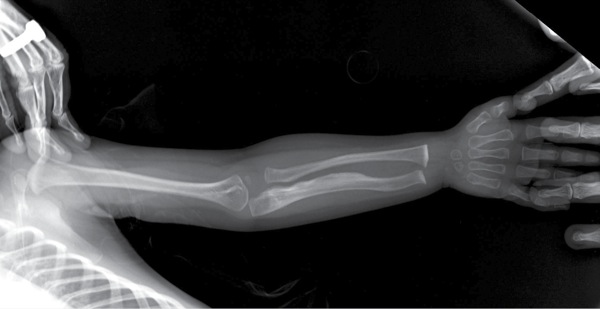What Is It?
Osteogenesis imperfecta (OI), or brittle bone disease, is a group of genetic bone disorders characterized by fragile bones that break easily. Severity of OI ranges from mild to severe.
The underlying pathophysiology is a connective tissue disorder caused by lack of type 1 collagen, which is associated with mutations in COL1A1 or COL1A2 genes in 90% of cases.1-3 The abnormality is inherited in an autosomal dominant manner or may occur through a new mutation. There are many types of OI with varying severity, age of onset, and other symptoms, and a few types that have mutations in other genes. Type I is the least severe. Type II is the most profound form; survival beyond the first year is rare, with death due to cardiorespiratory failure.
Incidence
Osteogenesis imperfecta affects about one in 15,000 births.3 Outcomes, although generally good, are variable and depend on the type of disease.4 Sexes are equally affected. The disease occurs worldwide, although differences in the proportion of types have been found in some African nations. Animals, especially some species of dogs, also are liable to develop OI.
Diagnosis
While OI patients are extremely susceptible to bone fractures, the age when breakages begin is highly variable. In type I, fractures may not occur until adulthood. In other instances of severe cases, fractures have been diagnosed in utero by ultrasound and in vitro genetic testing.
In addition to fractured and bowed bones, symptoms may include blueness of the sclera, short height, deafness, respiratory difficulties, and dental disease. Other complications are cervical artery dissection and aortic dissection.5
Diagnosis of OI is based mainly on imaging, such as plain x-rays, and finding the above symptoms. Pathological changes may be seen in all limbs and the spine. Cortical bones in OI show increased porosity, canal diameter, and connectivity during advanced tomography. A skin biopsy may help determine the structure and quantity of type 1 collagen. Further confirmation, if necessary, is made by DNA or collagen testing, although not all mutations causing OI are known.
Treatment
Even though there is no known cure for OI, exercise, a healthy diet, and avoiding smoking may help decrease the risk for fractures. Treatment includes splinting of broken bones, pain therapy, physical therapy, braces, and/or wheelchair use. Surgical intervention might include rodding of the long bones. A recent review supports the administration of bisphosphonates.6,7
In OI, the need for anesthesia is frequent and complications are uncommon.8 However, careful positioning and padding is essential. Application of a tourniquet must be done gently to avoid bone breakage. Extension of the head should be minimized to prevent cervical fracture or chipping of damaged teeth. The tongue is usually large, the neck short, and the cranium often deformed. Dwarfism is common. Respiratory infections should be managed preoperatively if possible. Hematologic and cardiac consults may be indicated. Patients with OI are more prone to hyperthermia and diaphoresis. Deafness may hamper communication. The odds of challenges in anesthesia are greater in severe OI, with significant blood loss and difficulty placing IV catheters.
The disorder in pregnant patients also requires special consideration.9 A restrictive lung pattern is worsened by the enlarged fundus. Regional anesthesia is preferred. Birth is usually by cesarean delivery, but because infants are generally preterm, neonatal complications are to be expected.
References
- Marini J, Smith SM. Osteogenesis imperfecta. In: Feingold KR, et al, eds. Endotext [Internet]. South Dartmouth, MA: MDText.com, Inc; 2000-2015.
- Sam JE, Dharmalingam M. Osteogenesis imperfecta. Indian J Endocrinol Metab. 2017;21(6):903-908.
- Folkestad L. Mortality and morbidity in patients with osteogenesis imperfecta in Denmark. Dan Med J. 2018;65(4). pii: B5454.
- Osteogenesis Imperfecta. Genetics Home Reference. US National Library of Medicine. https://ghr.nlm.nih.gov/ condition/ osteogenesis-imperfecta. Accessed December 29, 2018.
- Grond-Ginsbach C, Debette S. The association of connective tissue disorders with cervical artery dissections. Curr Mol Med. 2009;9(2):210-214.
- Dwan K, Phillipi CA, Steiner RD, et al. Bisphosphonate therapy for osteogenesis imperfecta. Cochrane Database Syst Rev. 2016;10:CD005088.
- Morello R. Osteogenesis imperfecta and therapeutics. Matrix Biol. 2018;71-72:294-312.
- Rothschild L, Goeller JK, Voronov P, et al. Anesthesia in children with osteogenesis imperfecta: retrospective chart review of 83 patients and 205 anesthetics over 7 years. Paediatr Anaesth. 2018;28(11):1050-1058.
- Kawakita T, Fries M, Singh J, et al. Pregnancies complicated by maternal osteogenesis imperfecta type III: a case report and review of literature. Clin Case Rep. 2018;6(7):1252-1257.



Leave a Reply
You must be logged in to post a comment.